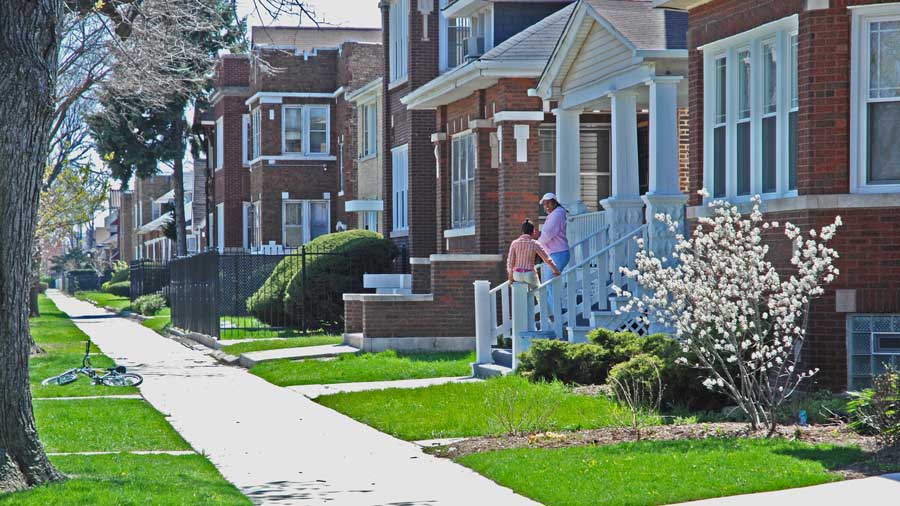
Overview
MacArthur’s How Housing Matters to Families and Communities initiative explores the notion that stable, quality housing may be an essential “platform” that promotes positive outcomes in education, employment, and physical and mental health, among other areas.
To that end, the foundation embarked on a five-year, $25 million research investment, which included support for a research network and 42 individual studies. As that research is published, MacArthur is producing a series of briefs to capture the essential findings and insights of each study and present them in an accessible way to help inform policy discussions on a range of topics.
The authors draw on interviews with 50 families in Cleveland and its suburbs to uncover their experiences in choosing a home and school for their children in the suburbs. Nearly all families were seeking the “package deal”— good schools in good neighborhoods — and looked to the suburbs to find it. Families were often convinced of the superior quality of suburban schools but, owing to the legacies of enduring structural racism and emerging segregation in the suburbs, Black families were more likely to be disappointed in their suburban schools than their white counterparts. Families of color were also constrained by the legacies of enduring structural racism that has reproduced racial inequalities.
Grantee: Johns Hopkins University
Principal investigators: Anna Rhodes, Siri Warkentien
New insights on the influence of a household’s social networks underscore the importance of breaking up concentrated poverty. Inclusionary zoning in Montgomery County, MD, has created more economically diverse communities and broader social networks for low-income residents. Those more diverse networks in turn are associated with less depression and smoking among low-income residents.
Grantee: Rand Corporation
Principal investigators: Heather Schwartz, Susan Burkhauser, Beth Ann Griffin, David Kennedy, Harold Green, Jr., Alene Kennedy-Hendricks, and Craig Pollack
At nearly one-fourth of all U.S. households, multifamily housing is an important target for energy savings. A new case study finds that installing more efficient air conditioning and other energy savers in a set of multifamily apartment buildings in Orlando, Florida, cut energy use by 18-22 percent and saved tenants $272 annually on average. For low-income tenants, who are more vulnerable to volatile monthly expenses, savings such as these are important.
Grantee: University of Florida, Shimberg Center for Housing Studies and Program for Resource Efficient Communities
Principal investigators: Nicholas W. Taylor, Jennison K. Searcy, and Pierce H. Jones
Siblings who lived in public housing as teenagers fared better than their siblings who had spent less time in public housing. For every year spent in public housing, youth earned about $500 more annually at age 26, and they were less likely be incarcerated. The largest effects were for Hispanic young women. Positive effects were also found for youth having lived in voucher-assisted housing, who earned about $250 to $480 more annually at age 26 than their siblings who spent less time in voucher-assisted housing. In this case, young women tended to benefit more than young men, with the largest effects accruing to Black young women. The study is an important advance over prior work in that it can account for household differences that might also influence a youth’s later earnings and likelihood of incarceration.
Grantee: University of Maryland-College Park
Principal investigators: Fredrik Andersson, John C. Haltiwanger, Mark J. Kutzbach, Giordano E. Palloni, Henry O. Pollakowski, and Daniel H. Weinberg
Children in Cleveland who lived for a prolonged time in homes that were in poor condition, tax delinquent, in foreclosure, or owned by a speculator had lower literacy scores on entering kindergarten than children who were more stably housed. Poor housing conditions were also linked to higher rates of child maltreatment, elevated lead levels, and residential instability, which are known to hurt kindergarten performance.
Grantee: Case Western Reserve University
Principal investigators: Claudia J. Coulton, Robert Fischer, Francisca Richter, Seok-Joo Kim, Youngmin Cho
The timing and number of moves influence children’s emotional and cognitive outcomes. Early childhood residential moves have enduring social and emotional effects, while middle childhood and early adolescent residential moves are associated with lower math and reading scores. Each additional move worsens the effects, as does moving schools at the same time. However, effects are small and some fade with time.
Grantee: Boston College
Principal investigators: Rebekah L. Coley, Melissa Kull
Chaotic homes and neighborhoods are tied to poorer health and developmental outcomes for young children. This study delves into these broad connections, showing that the source, the timing, and the intensity of chaos are important. In addition, it shows that a mother’s psychological distress is a critical link between chaos and children’s poor health outcomes.
Grantee: Boston College
Principal investigators: Rebekah L. Coley, Alicia Doyle Lynch, Melissa Kull
In high-poverty neighborhoods, poor housing conditions, overcrowding, poor neighborhood conditions, and a lack of neighborhood social cohesion are associated with depressive symptomology and hostility among residents. Symptoms were present for residents of both public housing and subsidized private rentals, suggesting that the risk is not dependent on the type of housing. The neighborhood characteristics, however, are important - particularly neighborhood social cohesion, which was associated with reduced symptoms.
Grantee: Albert Einstein College of Medicine (Formerly at Yeshivea University)
Principal investigators: Earle C. Chambers, Damaris Fuster, Shakira Suglia, Emily Rosenbaum
New data show who is at risk for defaulting on a reverse mortgage and ways to reduce risk while keeping the option open for more applicants.
Grantee: Ohio State University
Principal investigators: Stephanie Moulton, Donald Haurin, and Wei Shi
This brief builds on the growing understanding that affordable housing, via the additional income it provides families to invest in their children, has a strong connection to children’s cognitive development.
Grantee: Johns Hopkins University
Principal investigators: Sandra J. Newman, C. Scott Holupka
This brief examines differences in cardiovascular disease among low-income Latinos living in government-subsidized housing in the Bronx, with results showing that the prevalence of cardiovascular disease is significantly higher among public housing residents than Section 8 voucher holders and low-income Latinos in general.
Grantee: Yeshiva University
Principal investigators: Earle Chambers, Emily Rosenbaum
Children in families who were homeless or doubled up were more likely to have certain behavioral problems at age three and five and to use the emergency room for health care than more stably housed, yet equally poor children. However, this study finds it was not homelessness that was the reason for the distinctions. Several other factors, such as mothers’ education, health, and immigrant status, were more important determining factors.
Grantee: University of Illinois at Urbana-Champaign, School of Social Work
Principal investigators: Jung Min Park, Angela Fertig, and Paul Allison
Families receiving housing assistance generally live near an elementary school that ranks quite low on state test scores and has a high share of students who are poor. Among the four housing subsidies examined in this study, the Low Income Housing Tax Credit program performed the best in locating families near better performing schools.
Grantee: New York University
Principal investigators: Ingrid Gould Ellen, Amy Schwartz, and Keren Mertens Horn
This brief examines whether Housing Choice Vouchers can help break the cycle of poverty by allowing families to move nearer to higher-performing schools. Results suggest families still face constraints in doing so.
Grantee: New York University
Principal investigators: Keren Mertens Horn, Ingrid Gould Ellen, and Amy Ellen Schwartz
This brief examines the five-year effects—a longer timespan than most studies—of Housing Choice vouchers on neighborhood quality, earnings, and work effort. Over time, residents moved to higher-quality neighborhoods, although the number of hours worked and income earned initially declined following a move. Both work and earnings, however, rebounded after five years. Racial minorities and younger adults tended to see better results than voucher recipients who were white or older, respectively.
Grantee: University of Wisconsin - Madison
Principal investigators: Deven Carlson, Robert Haveman, Tom Kaplan, and Barbara Wolfe
Low-income women are evicted at much higher rates than men. The reasons are varied, including lower wages and children, but one rarely discussed reason is the gender dynamics between largely male landlords and female tenants. This brief, based on an in-depth look at evictions in Milwaukee, Wisconsin, finds that women’s non-confrontational approach with landlords and their tendency to dodge the issue are two reasons why women from black neighborhoods in Milwaukee represented only 9.6 percent of the population, but 30 percent of the evictions.
Grantee: Harvard University
Principal investigator: Matthew Desmond
Among the many potential factors reviewed in this brief, the evidence most consistently points to neighborhood social cohesion, informal social control, spatial mismatch, and exposure to environmental hazards, including violence, as important factors in how neighborhood affects personal outcomes.
Grantee: Wayne State University
Principal investigator: George C. Galster
Ten to fifteen years after low-income, inner-city families were given vouchers to move to lower-poverty neighborhoods as part of the Moving to Opportunity program, the results show that while health and happiness improved after the move, employment and children’s schooling outcomes did not. The results explored in this brief suggest that housing mobility policies alone are not a panacea for the complicated problems low-income families face.
Grantee: Northwestern University
Principal investigators: Jens Ludwig, Greg Duncan, Lisa Gennetian, Lawrence Katz, Ronald Kessler, and Lisa Sanbonmatsu
This brief examines how inclusionary zoning—which provides incentives for housing developers to build affordable homes in high-cost neighborhoods—can be an effective tool in helping low-income families move closer to better schools and into higher-income neighborhoods. Several features, however, could improve their reach.
Grantee: RAND
Principal investigators: Heather L. Schwartz, Liisa Ecola, Kristin J. Leuschner, and Aaron Kofner
Reducing traffic congestion with open-road tolling limits pollution and contributes to better infant health—and saves $440 million in health care costs, according to this brief. Among families living within 2 kilometers of expressway tollbooths, premature births fell by between 6.7 percent and 9.2 percent after the installation of E-Z Pass tolling systems. The incidence of low birth weight fell by between 8.5 percent and 11.3 percent.
Grantee: Columbia University
Principal investigators: Janet Currie and Reed Walker
The brief examines how housing quality and housing stability matter to children’s well-being. Living in unsafe or unsanitary homes is related to greater emotional and behavioral problems among children and adolescents, and poor housing quality is also related to poorer school performance for older children. Moving frequently is also detrimental to children’s well-being. In contrast, unaffordability had little discernible link to children’s well-being. Much of the effect of poor quality and unstable housing on children was a function of parenting. The strain of living in poor-quality homes or of having to move frequently took its toll on parents, leading to symptoms of depression and anxiety.
Grantee: Boston College
Principal investigators: Rebekah Levine Coley, Tama Leventhal, Alicia Doyle Lynch, and Melissa Kull



